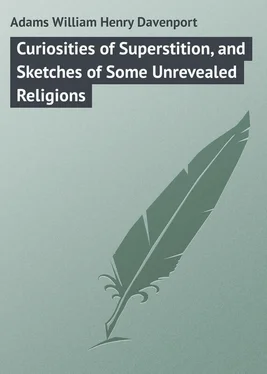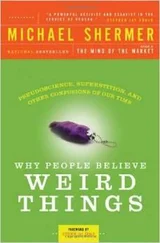William Adams - Curiosities of Superstition, and Sketches of Some Unrevealed Religions
Здесь есть возможность читать онлайн «William Adams - Curiosities of Superstition, and Sketches of Some Unrevealed Religions» — ознакомительный отрывок электронной книги совершенно бесплатно, а после прочтения отрывка купить полную версию. В некоторых случаях можно слушать аудио, скачать через торрент в формате fb2 и присутствует краткое содержание. Жанр: foreign_language, foreign_prose, на английском языке. Описание произведения, (предисловие) а так же отзывы посетителей доступны на портале библиотеки ЛибКат.
- Название:Curiosities of Superstition, and Sketches of Some Unrevealed Religions
- Автор:
- Жанр:
- Год:неизвестен
- ISBN:нет данных
- Рейтинг книги:4 / 5. Голосов: 1
-
Избранное:Добавить в избранное
- Отзывы:
-
Ваша оценка:
- 80
- 1
- 2
- 3
- 4
- 5
Curiosities of Superstition, and Sketches of Some Unrevealed Religions: краткое содержание, описание и аннотация
Предлагаем к чтению аннотацию, описание, краткое содержание или предисловие (зависит от того, что написал сам автор книги «Curiosities of Superstition, and Sketches of Some Unrevealed Religions»). Если вы не нашли необходимую информацию о книге — напишите в комментариях, мы постараемся отыскать её.
Curiosities of Superstition, and Sketches of Some Unrevealed Religions — читать онлайн ознакомительный отрывок
Ниже представлен текст книги, разбитый по страницам. Система сохранения места последней прочитанной страницы, позволяет с удобством читать онлайн бесплатно книгу «Curiosities of Superstition, and Sketches of Some Unrevealed Religions», без необходимости каждый раз заново искать на чём Вы остановились. Поставьте закладку, и сможете в любой момент перейти на страницу, на которой закончили чтение.
Интервал:
Закладка:
The prayer-mill sometimes contains the Tibetan prayer, or litany, for the six classes of living creatures, namely, the souls in heaven, the evil spirits in the air, men, animals, souls in purgatory, and souls in hell; but, as a rule, the Lama worship begins and ends in the famous inscription to which we have already alluded — Aum Mani Padmi Hoong (to the jewel in the lotus.) These mystic words are raised in embossed letters on the exterior of the cylinder, and are closely written on strips of paper inside. All the sacred places are covered with them; the face of the rock, the walls of the temple; just as the Alhambra glitters with its azulejos , its blazoned inscriptions from the Kúran.
This mystic sentence is composed as follows: Aum or Om , equivalent to the Hebrew Jah or Jehovah, the most glorious title of the Almighty; Mani , the jewel, one of Buddha’s appellations; Padmi , the lotus, in allusion to his lotus-throne; and Hoong , synonymous with Amen . The Buddhists regard this “six-syllabled” charm as a talisman of never-failing efficacy; but by some of the sects it is more or less varied. For instance: the Chinese Fo-ists read it as Aum-mi-to-fuh , which is also one of Buddha’s titles; and every devout Fo-ist aims at repeating it at least three hundred thousand times in the course of his life. Some of their priests will shut themselves up in the temples for months at a time, and devote themselves to the dreary task of repetition, hour after hour, day and night. Sometimes, ten or twelve devotees will voluntarily sequester themselves, and continue all day to cry aloud in chorus; and at night they undertake the task successively, one person droning through the monotonous chant while the others sleep. Thus do they think to be heard for their much speaking! Similar excesses of formalism, however, are recorded in the history of mediæval Christianity, – in the biographies of saints and ascetics who have substituted for a practical Christianity and the active performance of social duties the dreary vanity of an unprofitable solitude, spent in the discharge of useless penances.
The Buddhist prayer which is consecrated to Buddha as the Chakravarta Rajah, or King of the Wheel, proves, on examination, to be closely related to that Sun-worship which prevailed in the early ages of the world. The wheel is, in many creeds, the symbol of the sun’s chariot, that is, of the revolution of the heavenly bodies. In a sculpture, nearly two thousand years old, on the Bilsah Tepe, Buddha is represented simply by a wheel, overshadowed by the mystic chattah , or golden umbrella, which is a common emblem of his power. His worshippers are represented as making their offerings to the King of the Wheel. “This sacred Wheel of the Law, or Wheel of Faith, is found again and again among the fain and Buddhist sculptures in the caves of Ellora and Ajunta, in most cases projecting in front of Buddha’s Lotus-Throne. In one instance an astronomical table is carved above the wheel. In another it is supported on either side by a stag, supposed to represent the fleetness wherewith the sun runs his daily circuit, ‘going forth from the uttermost part of the heaven, and running about unto the end of it again.’”
Visiting the Temples at Hardwar, one of the sacred cities of India, Miss Gordon Cumming remarks upon the number of their hideous idols, painted and carved, their multitudinous brass bells, their brazen horns, their sacred courts all covered with elaborate carving, and their mythological sculptures.
She says: – “I frankly confess that there is something startling in the rapidity with which one gets quite at home amongst all this paraphernalia of heathenism, and how very soon idolatry ceases to shock the mind, and becomes merely a curious study with picturesque adjuncts. Six months previously the sight of a veritable temple with its hideous idols and devout worshippers was a thing from which one shrank in shuddering pity.” But she soon became a connoisseur, and “lounged from one temple to another, inspecting jewels and exquisite stone carving, and anything wonderful the priests had to show, and quite forgot to be shocked, it was all so perfectly natural, and seemed so entirely in keeping with the tastes of the people.” In this remark there is a wonderful naïveté ; for it may reasonably be supposed that the tastes of the people would be in accord with a religion which, during its career of two thousand years, must have exercised so great an influence in forming them!
In some of the temples, according to the same writer, there are sacred bulls, carved in white marble and adorned with costly necklaces. In others the attendant priests spend the whole day in pouring single drops of precious oil on holy pebbles brought from the Nerbudda and other sacred streams, and here arranged in little trays. Amongst the privileged inhabitants are the monkeys, who frolic about incessantly with their babies in their arms, or sitting on their backs, and twining their little arms round the parental necks.
The ceremonies in the different temples are, on the whole, very similar; and the following description, taken from the Rão Mãlã, applies, except in minor details, to all.
The day is marked by five services: the first at sunrise, when bells are rung in the temple, and drums or conch-shells sounded, to rouse the Du, or god, from his slumbers. After performing copious ablutions, the officiating priest enters the holy place, and swings before the idol a lamp with five or seven branches. An hour or two later, the Du is attired in raiment appropriate to the season. He wears a quilted coat in cold weather, and has a lighted brazier placed beside him; whereas, in hot weather, he is anointed with sandal-wood dust and water, clothed in fine linen, and decked out with gems and flowers. Placed close to a cool fountain, he is assiduously fanned by his attendants. In rainy weather, he is wrapped about in scarlet cloth and shawls. When he is dressed, a light breakfast of rice and milk is served up, and his votaries perform “the sixteen acts of worship.” At noon a third service takes place. The Du is again rubbed with oil of sandal-wood, or sandal-dust and water, and adorned with fresh flowers. The lamps are trimmed; incense is burned; and his dinner is set before him: after which he is supposed to indulge in his noonday sleep, and profound silence is maintained throughout the temple.
At three in the afternoon a drum beats, and the god awakes! His attendants hasten to serve fruits and sweetmeats, and perform various games for his amusement. At sunset he is enshrined: his feet are basted, he is sprinkled with water, his mouth is washed, and another offering is made of sandal-wood dust, and flowers, and incense. He is once more clothed; an elaborate dinner is spread before him; betel leaves are presented; and again the many-branched candlestick is waved, while all the votaries present for the second time perform “the sixteen acts of worship.”
The last service takes place at night, when the image is supposed to sup on bread and water. After receiving the usual oblations of incense and flowers, he is undressed, and if he be movable, put to bed, or if not, is warmly covered with shawls and quilts.
Not the least remarkable objects in the Hindu temples are their great statues of bulls in marble or in metal. It is worthy of note that “in the great Brazen Laver, which Solomon was commanded to make for the use of the Temple at Jerusalem, the symbols selected for the adornment of that consecrated Molten Sea should have been those which in later ages were to hold so prominent a place in the symbolism of faiths so widely spread as those of Brahma and Buddha. That huge laver was supported by twelve oxen of cast metal, three looking to each point of the compass, while the brim of the great sea itself was all wrought with flowers of lilies, much the same as the pattern of lotus or water-lily with which the shrine of Buddha is invariably edged.” The bull is another symbol which seems to connect the creed of the Hindu with the old nature-worship; for the vernal equinox takes place when the sun enters the sign of Taurus, and this event was always and everywhere a signal for feasting and rejoicing.
Читать дальшеИнтервал:
Закладка:
Похожие книги на «Curiosities of Superstition, and Sketches of Some Unrevealed Religions»
Представляем Вашему вниманию похожие книги на «Curiosities of Superstition, and Sketches of Some Unrevealed Religions» списком для выбора. Мы отобрали схожую по названию и смыслу литературу в надежде предоставить читателям больше вариантов отыскать новые, интересные, ещё непрочитанные произведения.
Обсуждение, отзывы о книге «Curiosities of Superstition, and Sketches of Some Unrevealed Religions» и просто собственные мнения читателей. Оставьте ваши комментарии, напишите, что Вы думаете о произведении, его смысле или главных героях. Укажите что конкретно понравилось, а что нет, и почему Вы так считаете.












